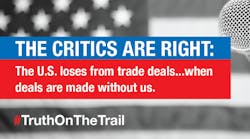#TruthOnTheTrail: Trade Realities That Campaigns Need to Consider
Trade continues to be a key topic in the campaigns of both major parties. Unfortunately, the most oft-repeated claims are flat-out wrong and portend a dangerous path of retreat from the strong trade approach that has long been a powerful positive force for American workers, consumers and families. With World Trade Week officially under way, let’s look again at how trade drives the U.S. economy, raises standards of living for American families and grows manufacturing in the United States by dispelling some of the top trade myths.
- Free Trade Agreements. If candidates want to take aim at free trade agreements (FTAs), why not go after the hundreds of trade agreements being negotiated without the United States that exclude and disadvantage manufacturers in the United States? U.S. exporters face higher tariffs and barriers than most of the world’s exporters in other countries (ranking 130 out of 132) because the United States has too few, not too many, trade agreements. FTAs are huge market boosters for manufacturing in the United States because they promote fair trade by leveling the playing field. That’s why moving forward on the Trans-Pacific Partnership (TPP) is so important to manufacturers in the United States.
- NAFTA. The criticism of the North American Free Trade Agreement (NAFTA) is an enduring but deeply flawed myth. The United States implemented NAFTA in 1994 and then experienced four years of economic growth and the creation of more than 800,000 manufacturing jobs. The recession in the late 1990s had a negative effect on the U.S. economy and jobs, but if anything, NAFTA helped the United States endure that downturn more successfully and has been critical to sustaining and growing the U.S. manufacturing sector, which then faced even stronger challenges from Asian emerging economies.
- China. It is easy for candidates to go after China as a major villain in the trade stories they like to tell. China is not easy, but it is not a one-sided picture. Yes, China has grown its manufacturing industry heavily over the past 20 years and is now the largest foreign supplier of manufactured goods to the United States. To reach this level, China engaged in a number of unfair trade practices, government subsidization and discriminatory policies. No debate there. At the same time, China also became the third-largest market for U.S.-manufactured goods, from the seventh-largest purchaser in 2002, the year after China joined the World Trade Organization, with U.S. exports growing more than 350 percent to $89 billion. There’s a long way to go in creating a fairer and more reciprocal U.S.–China commercial relationship, but it’s a lot more complicated than the campaign promise of putting on new border taxes on Chinese imports, which we all know would be contrary to U.S. international commitments and would likely result in even stronger retaliation against U.S. exports to China. And just a reminder, the TPP does NOT include China.
- Trade Deficits. When we buy more imports than sell exports, that’s considered a trade deficit, which is used by candidates as a negative report card on U.S. trade. However, our economy is much more complicated than simple subtraction. Oftentimes, when the U.S. trade deficit is rising, the U.S. unemployment rate is declining and U.S. manufacturing production is growing. Also, the critics conveniently ignore when we do have a surplus, such as the fact that our country sells more manufactured goods overall to our FTA partners than we purchase from them. U.S. manufacturing output and exports have quadrupled over the past quarter century. Trade, boosted by trade agreements, is helping to fuel our economy.
Trade and manufacturing go hand in hand. The United States manufactures more today than we have in our entire history. Trade and trade agreements have opened the door to new global opportunities for manufacturers big and small throughout America, helping to sustain and grow jobs for millions of Americans. Let’s continue to make sure manufacturers and America can continue to grow.





